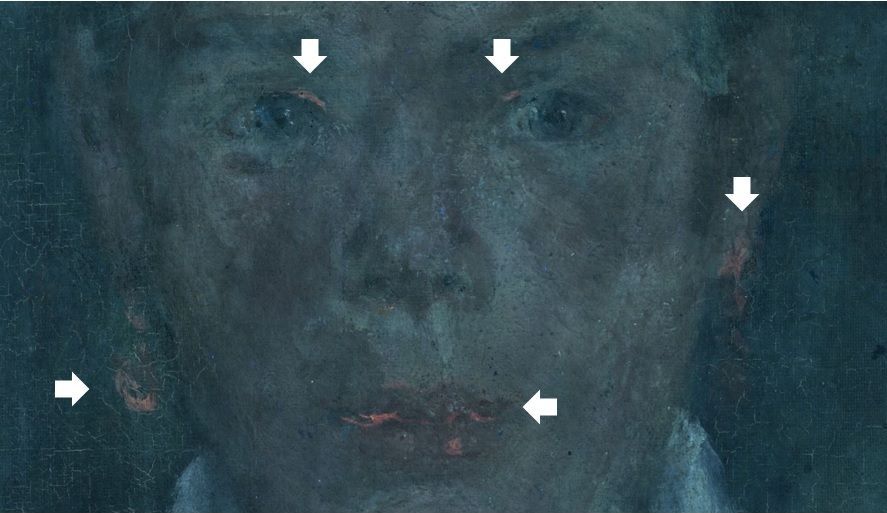Ensor painted over his own work

James Ensor reworked or overpainted several of his canvases. This much we know from earlier studies. KMSKA researchers Annelies Rios-Casier and Herwig Todts have been taking a deeper look into the subject as part of the Ensor Research Project (ERP). Their preliminary findings have identified three ways in which Ensor made overpaints: complete overpainting, partial but significant reworking, and the final touch. What does it all mean in practice? Read all about it here.
Complete overpainting
James Ensor occasionally recycled old canvases by painting entirely new compositions on top of them. We have found that he mainly overpainted works he had done during his time at the Academy and the years that followed. Was Ensor dissatisfied with the original painting? Had he temporarily run out of other canvases to use? Was the artist struggling financially at the beginning of his career? Technical assessment argues against the latter possibility: Ensor mostly used high-quality (and hence expensive) materials, which helps explain why his works are still in such good condition. For the time being then, why he painted over particular canvases will have to remain a mystery.
There is a fine example of complete overpainting in our own collection. A few years ago, Karen Bonne discovered a study of a man with beard beneath Still Life with Chinoiseries from 1880 (inv. 2076). When he overpainted the earlier composition, Ensor worked onto it directly rather than covering it over first with an even layer of colour. This seems to have been his regular practice when completely overpainting an earlier work: there are only a few exceptions where he did apply an intermediate layer.
Further research will be needed to determine why Ensor mostly preferred not to use such a layer and whether overpainting also occurred in his later work.

X-radiograph of Still Life with Chinoiseries, in which the underlying academic study of a man with beard is clearly visible. X-radiograph created by Adri Verburg

Digitally processed image showing the man’s position. Image created by Karen Bonne.
Partial but significant reworking
Ensor’s paintings sometimes remained in his studio for a long time, giving him the opportunity to rework compositions. He turned a few paintings into entirely new works by adding masks, grotesques, or a totally different hat. That’s how the Self-portrait with Flowered Hat (inv. SM000157) from the collection of Mu.ZEE in Ostend got its makeover. Ensor gave himself a striking hat decorated with flowers and feather.
Once again, these reworkings seem mostly to relate to paintings from Ensor’s early period, which were typically done with a dark palette. When the artist revisited them, he used the brighter and more intense colours of his later work, often including pigments that he had not yet adopted at the beginning of his career. Because of this, the new elements are easily recognizable.
Final touch
Some of the overpaints are very subtle, consisting of retouches or accents that subtly liven up the painting. The KMSKA’s Ensor expert, Herwig Todts, suspects that Ensor did this in order to freshen up a painting before selling or exhibiting it. In Woman with Upturned Nose (inv. 2077) from our own collection, we find touches of paint like this in the face, the eyes, the earrings and the lips.

Deze latere toevoegingen geven een oranje/roze fluorescentie onder UV-licht. Dit wijst op het gebruikt van een bepaald soort rode lak die Ensor nog niet gebruikte in 1879, toen hij de Vrouw met de wipneus schilderde. We hebben niet altijd het geluk dat we deze aanpassingen kunnen terugvinden. Het is zeer moeilijk om een onderscheid te kunnen maken tussen retouches die Ensor zelf zou hebben uitgevoerd en retouches die werden gedaan door restauratoren. We blijven met verschillende scanapparatuur verder zoeken naar Ensors eigen verfstreken.
The later additions show an orange/pink fluorescence under UV light, indicating the use of a certain type of red lake that Ensor had yet to adopt when he first painted the Woman with Upturned Nose in 1879. We are not always lucky enough to identify these adjustments. It is hard to distinguish between retouches that Ensor might have made himself and those of later conservators. We will continue our search for Ensor’s own paint strokes using a variety of scanning devices.

detail of the lips; image from Resource Space.

Detail of the lips under UV light, in which the pink/orange fluorescence is clearly visible.




